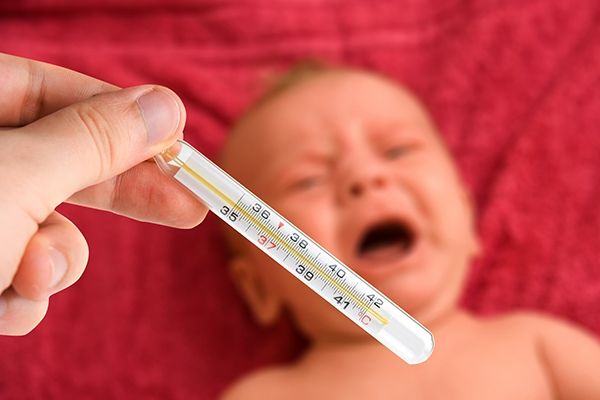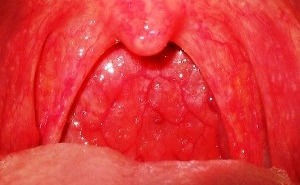The initial stage of the disease is sometimes simply invisible. It would seem that everything is in order, nothing hurts, but a couple of hours pass and the situation changes dramatically.
Discomfort appears very similar to a painful condition.
If the throat is red, but does not hurt, this does not mean that you need to forget about it.
Of course, sometimes you don't need to go to the doctor right away; one rinse, for example, with sage, may be enough.
But redness in the throat can also be caused by a serious illness, when a doctor's intervention is simply necessary.
The onset of the disease is always expressed by characteristic symptoms:
- The high temperature does not subside for more than three days;
- The throat constantly hurts;
- Difficulty swallowing, children may even refuse to eat;
- Great redness of the throat;
- Modified structure;
- Pain other than a runny nose and cough;
- Labored breathing;
- Swollen tongue;
- Vomiting;
- Temperature;
- Lymph nodes became inflamed.
In all of the above cases, an urgent visit to a therapist is required.

He will establish the correct diagnosis and prescribe the appropriate treatment.
Such infections are widespread. You can get infected anywhere, and it can happen many times. In most cases, children start to get sick.
The infection affects infants much less often. The fact is that they have less contact with the people around them, they have an innate immunity from their mother.

The virus can have several varieties:
- Flu strain;
- Parainfluenza;
- Adenovirus;
- Coronovirus;
Infection occurs by contact. The main viral diseases are: sinusitis, bronchitis, otitis media, pneumonia.
If the throat is red but not sore, this may be the first symptom of catarrhal sore throat. It is characterized by a rather mild course of the disease.

The tonsils are affected only superficially. Sometimes a sore throat is almost imperceptible. The doctor diagnoses the following symptoms of the disease:
- Inflammation of the cervical lymph nodes;
- Heat;
- Lethargy;
- Inability to work;
- Enlarged tonsils;
- Hard to swallow.
The cause of catarrhal sore throat can be infectious diseases, hypothermia, lack of vitamins.
Acute angina
The formation of tonsillitis takes about three days. The tonsils and pharyngeal mucosa are covered with pathological rashes.

In chronic tonsillitis, changes in the tonsils are not observed.
When the throat is not sore but has severe redness, the doctor may diagnose tonsillitis.
The disease has characteristic symptoms of persistent high fever, redness of the tonsils, dizziness, nausea, diarrhea, general intoxication.
Laryngotracheitis
In some cases, if there is no pain in the throat, but it looks very red, doctors talk about laryngotracheitis. In this case, the disease affects the trachea and throat.
I suggest to watch a useful video:
Loss of voice is considered the main feature of this disease. Other symptoms of the disease include shortness of breath, barking cough, slight tingling in the throat, scratching.
Only a doctor can prescribe the appropriate treatment. Before visiting a therapist, you can:
- Speak only in a whisper or be silent;
- Drink only warm milk;
- Carry out herbal inhalation.
The doctor will write out medicationsthat will help to cope with such a disease.
Breastfeeding and sore throat
If a newborn baby has a very red throat, this may indicate the presence of a sore throat.
At this time, the child has a high temperature that does not subside for a long time.

It is impossible to cure such a disease with folk methods. Only a pediatrician can prescribe the necessary medications.
Prescribe antibiotics if needed. It is strictly forbidden to self-medicate!
Baby and red throat
The type of treatment depends on the age of the baby, the state of inflammation and the type of infection. The child needs peace, he needs to eat right.

Sweet, fatty, spicy, smoked, salty should be excluded from his diet.
It is advisable to give the child slightly warmed meat broths. You can make fish or vegetable broth.
Sore throat medications
With angina and acute tonsillitis, "Lisobakt" is prescribed. Perfectly copes with manifestations of catarrhal sore throat and laryngitis "Teraflu" For infectious diseases of the throat, "Efizol" is prescribed.
Here's another interesting addition in video format:
If the cause of the reddening of the throat is a bacterial infection, special groups of antibiotics are used.
Most effective means for inflammation and redness of the throat are: "Sumamed", "Amoxiclav", "Tsiprolet", "Bioparox".
These medicines are produced in the very in different ways: tablets, sprays, suspensions.
In case of special need, special antibiotics are prescribed, administered intravenously.

Only a doctor can prescribe the required antibiotic. Self-medication can lead to serious complications.
You do not need to deal with a red throat on your own, be sure to consult your doctor.
Probably everyone has encountered a sore throat. And often it can hurt only on one side. Very unpleasant sensations, it is difficult to swallow, and sometimes even to talk. How to treat sore throat, if there is no temperature and why does the inflammatory process occur?
Causes of sore throat without fever
If a sore throat is sore, then many are convinced that this is the first symptom of an impending infectious disease. In most cases, this happens, after a runny nose and high fever are added to the sore throat.... In some cases, it happens that, but the temperature remains normal. The reasons for this may be the following:
A sore throat without fever, on one side or both, may appear with viral and respiratory diseases in the event that a person has weakened immunity. The fact is that an increase in body temperature signals the beginning of the fight against harmful organisms. If the protective functions are weakened, then there can be no increase in temperature. When viral infections there is often a dry, excruciating cough and runny nose, and the head turns with severe muscle pain.
Many conditions can contribute to a sore throat. The main thing is to find the cause and eradicate it, and not fight directly exclusively with painful sensations in the throat.
Sore throat
Various diseases are one of the most common without fever. Angina, not always accompanied high temperaturebut there is a severe sore throat and it is red. In this case, the throat may also hurt only on one side. All these diseases are caused by pathogenic bacteria, severe inflammation appears, it is difficult for a person to swallow and speak.
One of the causes of pain, in addition to diseases, can get into the throat foreign bodyfor example, a small toy might be swallowed by a child. In an adult, a foreign object can get in with food (small bones, a hard piece of bread). In this case, there is no temperature, but either from both. In this case, you need to contact a specialist and conduct an examination.
Dental problems and various kinds of injuries
Many people in vain assume that dental problems have nothing to do with the general condition of the body. On the contrary, many diseases of the teeth and gums can be one of the causes of health problems. For example, stomatitis and periodontitis cause severe inflammation, because pathogens along with saliva enter the throat and actively progress there, but the body temperature does not rise and this is one of the causes of inflammation.
Aphthous stomatitis is one of the most common problems in an adult. With this disease, very severe pain in the throat, in which there is no temperature. Symptoms of this disease are aphthae - ulcers on the mucous membrane of the larynx and mouth. The submandibular lymph nodes are also greatly enlarged.
Throat injuries can also cause severe pain, and this should be given the utmost attention.
Burns of the throat when drinking too hot drinks can also be one of the reasons. It is worth remembering that the mucous membrane of the throat is very sensitive, so you should not eat too hot or cold food, the same applies to drinks.
To treat and get rid of WET, our readers successfully use a natural remedy for WET. It is a 100% natural remedy, based solely on herbs, and blended in such a way as to effectively fight the disease. The product will help to quickly and effectively defeat coughs in a short time, and once and for all. Since the drug consists only of herbs, it has no side effects... Does not affect blood pressure or heart rate. Get rid of phlegm ... "
 If the throat is red, you need to see a doctor, but when there is no such possibility in the near future, then you can try to alleviate the discomfort yourself, because the pain in the throat, even on the one hand, is really painful. First of all, give up completely from smoking and alcohol, this irritates the mucous membrane and will cause even more unpleasant sensations. Try not to overextend your ligaments, scream, and it is best not to talk at all.
If the throat is red, you need to see a doctor, but when there is no such possibility in the near future, then you can try to alleviate the discomfort yourself, because the pain in the throat, even on the one hand, is really painful. First of all, give up completely from smoking and alcohol, this irritates the mucous membrane and will cause even more unpleasant sensations. Try not to overextend your ligaments, scream, and it is best not to talk at all.
Drinking warm and gargling is best if the throat is completely red or only on one side. Drink as much warm (not hot!) Tea, juice, compote as possible, rinse the mucous membrane with solutions. You can make a soda or salt-soda solution, they will work well if the throat is red. This rinsing will reduce swelling, slightly relieve inflammation and reduce your suffering. To reduce discomfort, take a pain reliever, use special lozenges with an antibacterial effect. Be sure to consult your doctor. In some cases, antibiotics are indispensable!
Sore throat treatment
You should immediately pay attention that if the throat hurts and is red, but there is no temperature, then everything should be treated exactly. The lack of temperature does not mean at all that inflammatory process also no. It is necessary to initially find the causes and eliminate them.
You need to urgently contact a specialist if:
- dizziness appears;
- the throat is red;
- weakness appears;
- breathing problems are observed;
- there is a sharp loss in weight;
- there are blood or mucous impurities in the feces;
- acute sore throat accompanied by chills, abdominal pain, vomiting, and nausea.
The doctor will conduct an examination, prescribe all the necessary tests and find out the causes of the disease. After that, treatment is prescribed based on the patient's history.
Basic treatment methods
If there is no temperature, but the throat is very red and the head hurts, then heat compresses help well in this case. For them, you can take an infusion of chamomile, dip a napkin in it and apply it to the throat and head. Chamomile tea is also great for gargling.
 If the pain appeared due to prolonged runny nose, and this happens often, headache, weakness arises. After all, a person cannot breathe through the nose, only through the mouth, thereby the mucous membrane dries out and becomes irritated. In this case, treatment of the common cold is necessary. Use special sprays and drops. You can make inhalation from burdock root or decoction of chamomile flowers. Repeat the procedure 3-4 times a day, while it is important to keep bed rest.
If the pain appeared due to prolonged runny nose, and this happens often, headache, weakness arises. After all, a person cannot breathe through the nose, only through the mouth, thereby the mucous membrane dries out and becomes irritated. In this case, treatment of the common cold is necessary. Use special sprays and drops. You can make inhalation from burdock root or decoction of chamomile flowers. Repeat the procedure 3-4 times a day, while it is important to keep bed rest.
For a common cold, you should take drugs that contain zinc. Zinc glucanate will quickly eliminate symptoms and relieve the condition, eliminate sore throat, but such drugs are not recommended for more than a week. It is also worth noting that if the patient does not have a fever, but the throat is red, then you can soar your legs, put mustard plasters. After the procedures, the patient should go to bed, wrap up well and sweat. It is known that toxic and harmful substances tend to escape through the pores of the skin. Do not forget to take a variety of vitamin complexes during illness, in particular, vitamin C.
It boosts immunity and helps fight disease. All procedures are recommended for at least a week, and not until the first relief.
Please note that if pain is present in a pregnant or lactating woman, then treatment with many drugs is prohibited. It is worth being careful with herbal teas, many of them can greatly increase the uterine tone. Before using any medication or folk remedies it is worth consulting a doctor. The same applies to children. Do not self-medicate, because this approach can lead to unpleasant and unpredictable consequences.
Prevention
Each disease is easier to prevent than after long and expensive treatment. If your throat hurts without fever, you can't let it go. Treatment should be started immediately. Monitor your health, prevent not only hypothermia, but also overheating. In cold and slushy weather, make sure that your feet do not get wet, and if this happens, you need to change your shoes as soon as possible, rub your feet with cologne or vodka, and put on woolen socks.
To prevent sore throat, you need to take special immunomodulating drugs, vitamins, drink decoctions of rose hips and herbs. It is easier to deal with any disease at the initial stage, therefore, if the first symptoms of the disease appear, immediately start treatment, observe bed rest and the disease will never give complications and will proceed in a weaker form.
Speaking about redness of the throat, most often patients mean a change in the color of the mucous membrane of its small area visible during examination, that is, the pharynx and part of the pharynx.
Often, the redness of the pharyngeal mucosa, if it is constantly observed in a person, is associated with his lifestyle, habits, the air he breathes, nutrition.
Why does the throat mucosa turn red? This phenomenon has 2 main reasons:

- Hyperemia is a rush of blood to the vessels of the mucous membrane of the pharynx and pharynx, as well as the expansion of these vessels, which subjectively looks like a red throat.
- Staining the mucous membrane with any food coloring.
By the way, the situation with dyes is more than real. For example, a child constantly has some kind of redness in his throat, moreover, nothing bothers him anymore, the doctors say he is healthy.
And then it turns out that the favorite and regularly eaten by the child caramels have a small drawback, namely the unstable dye, which gives such a "side effect".
As for hyperemia, that is, the expansion and filling of blood vessels of the mucous membrane, then, in fact, it is a defense mechanism of our body that occurs in response to various stimuli.
As you can see, many of the reasons that a person may constantly be bothered by the redness of the mucous throat have nothing to do with diseases. Therefore, having found a red throat in yourself, especially if no other symptoms bother you, do not rush to look for a disease or run to a doctor. First, check if there are other non-pathogenic factors in your life that can provoke a discoloration of the mucous throat.
Chronic diseases
It is quite natural to change the color of the mucous membranes of the pharynx with the pharynx in an adult or a child suffering from acute respiratory infections (angina, ARVI). But what about those who do not have a red throat even after the symptoms of acute respiratory infections disappear and lasts for months?

Such patients can be advised to consult an ENT doctor, since it may well turn out that the reason for this phenomenon lies in the presence of a chronic infection - tonsillitis or pharyngitis.
Examination of the throat helps the doctor to understand the localization of the main focus of chronic infection. What can be seen there with different pathologies:
- In chronic tonsillitis, slightly enlarged, slightly red tonsils are found, often having a loose surface or single light plugs in the lacunae.
- In chronic pharyngitis, the pharynx and tonsils look normal, but back wall the pharynx seems reddened, moreover, most often quite slightly, on its surface multiple tubercles are visible - lymphatic follicles.
By the way, people with chronic rhinitis (inflammation of the nasal mucosa) often have a slight cough and a red throat. The reason for this lies in the fact that mucus from the nose in such patients constantly flows into the pharynx and irritates its walls, hence, in fact, redness and coughing are taken.
We have already said that the pharynx is an organ belonging to two systems simultaneously. Therefore, if there is no pathology on the part of the respiratory system, and the red throat does not go away in any way, you should consult a gastroenterologist about this and look for the cause already from the digestive system.
This will be especially true for those who are constantly tormented by heartburn or belching.
Do you still think what to get rid of persistent colds, FLU and THROAT DISEASES is impossible !?
Judging by the fact that you are reading this article, you know not by hearsay what it is:
- severe sore throat even when swallowing saliva ...
- constant sensation of a lump in the throat ...
- chills and weakness in the body ...
- "Breaking" of bones at the slightest movement ...
- complete loss of appetite and strength ...
- constant nasal congestion, and coughing up snot ...
Now answer the question: does this suit you? Is it ALL THESE SYMPTOMS CAN BE ENDED? And how long have you already "wasted" on ineffective treatment? After all, sooner or later the SITUATION WILL BE DECREASED. And the matter can end in tears ...
That's right - it's time to start ending this problem! Do you agree? That is why we decided to publish an exclusive elena Malysheva's techniquein which she revealed the secret of strengthening immunity in children and adults, and also talked about the methods of prevention of COLD DISEASES.
Most of the patients who go to the otolaryngologist complain of redness of the throat. However, symptoms such as fever, dryness in the oropharynx, and malaise may be absent. When there is a red throat, one should not wait for the appearance of new clinical signs of the disease, but begin treatment. However, it is necessary to understand what caused the disease.
Now let's take a closer look at why the throat turns red, what provoking factors contribute to this and what is recommended to do. There are two groups of reasons:
- non-infectious;
- infectious.
Non-infectious throat injury
Given the considerable likelihood of damage to the oropharynx by non-infectious factors, we highlight the most frequent ones that lead to. The temperature in this case is observed only in case of infection of the damaged mucosa and the development of an inflammatory reaction:
- mechanical injury. They are observed due to a violation of the integrity of the mucous membrane of the pharynx by solid products, for example, crackers, or due to choking during food intake. First of all, it is dangerous due to asphyxiation due to reflex bronchospasm when a foreign element enters the respiratory tract. After removing the object, redness of the throat and some perspiration may occur. In addition, the appearance of hyperemia of the oropharynx after prolonged screaming, singing or laughter should be noted. Chronic redness is typical for people whose profession is associated with public speaking (vocalists, announcers);
- inhalation of contaminated (dust, industrial hazards), dry, cold air, due to which the mucous membrane is irritated and becomes hyperemic;
- thermal damage to the mucous membrane of the throat during inhalation with hot steam, inhalation of corrosive fumes, which leads to a chemical burn. Also, damage to the mucous membrane is possible when eating hot food or liquids;
Thermal damage requires qualified medical care, since untimely treatment leads to the formation of scar tissue and irreversible changes in the mucous membrane of the pharynx.
Especially dangerous are burns with chemical agents that have entered the digestive tract, provoking cicatricial stenosis of the esophagus, as well as in the organs of the respiratory system.
If the throat is red, but does not hurt, you should suspect the negative impact of the allergic factor. After contact of the oropharyngeal mucosa with a provoking allergen ( chemical substances, fluff, pollen, citrus fruits, hygiene products) a local immune response develops. It can be expressed as allergic pharyngopathy. 
Note that in this case elevated temperature no. Depending on the aggressiveness of the allergic factor and the sensitivity of the immune system to it, redness of the throat may be the only symptom or be accompanied by the appearance of other clinical signs.
A person may be worried about:
- perspiration, soreness in the oropharynx;
- sneezing, itching;
- swelling of the pharyngeal mucosa;
- rhinorrhea, nasal congestion;
- lacrimation, signs of conjunctivitis.
With the development of a systemic response to an allergic factor, a skin rash may appear.
In severe cases, bronchospasm and pressure reduction are possible.
To alleviate the condition, it is necessary to stop contact with the allergen. If the allergen was food, sorbents should be taken, for example, Atoxil, Polysorb or Enterosgel. This will help prevent further absorption of allergic substances and accelerate their elimination.
Drinking plenty of fluids, taking antihistamines such as Suprastin, Loratadin or Erius is also recommended. In severe cases, intravenous administration of hormonal agents and infusion therapy are required.
To prevent the re-development of an allergic reaction, it is necessary to establish the cause of its development. The patient should remember what he ate on the eve of the worsening of his condition, what he used and where he was. To determine the exact allergen, allergy tests are carried out after the condition improves. If necessary, preventive therapy is prescribed during the flowering season of plants or poplar fluff.
Infectious causes
Anyone can get sick with an infectious pathology, because pathogenic microorganisms are ubiquitous and very infectious. The development of the disease depends on the level of a person's immune defense and the presence of concomitant pathologies.
In most cases, the throat is red, but does not hurt in chronic inflammatory diseases, when infectious pathogens are present in the focus and maintain inflammation. Such chronic diseases include:
- pharyngitis;
- angina;
- sinusitis;
- laryngitis.
During the period of remission, the disease does not show pronounced clinical signs. Periodically, perspiration in the oropharynx, dryness, scratching, burning or tickling sensations may bother you. The temperature is often kept within normal limits, and there are no general symptoms at all.
 Pathologies are characterized by the appearance of soreness in the throat when swallowing, talking, an increase in temperature to subfebrile or febrile numbers. Also worried about a dry cough with a gradual transition to wet, in which copious sputum is released. The cough can be in the form of attacks or be observed constantly, intensifying in the morning, as sputum accumulates in the bronchi.
Pathologies are characterized by the appearance of soreness in the throat when swallowing, talking, an increase in temperature to subfebrile or febrile numbers. Also worried about a dry cough with a gradual transition to wet, in which copious sputum is released. The cough can be in the form of attacks or be observed constantly, intensifying in the morning, as sputum accumulates in the bronchi.
Of common symptoms It should be noted headache, severe malaise, drowsiness, fatigue, myalgia, arthralgia, body aches, dizziness and loss of appetite.
The diagnosis is established on the basis of clinical signs and the results of laboratory and instrumental examination. To examine the oropharynx, pharyngoscopy and laryngoscopy are used. The study visualizes:
- hyperemia;
- swelling of the mucous membrane;
- thickening of the arches, uvula;
- looseness of the tonsils;
- accumulation of purulent discharge in follicles, lacunae;
- the plaque can be white-yellow or gray, located on the tonsils, palate, arches and posterior pharyngeal wall;
- dryness, thinning of the mucous membrane, on the surface of which crusts are located, which indicates an atrophic process.
With laryngitis, the listed signs of inflammation relate to the larynx and vocal cords. The endoscopic picture changes depending on the form of the chronic process (catarrhal, hypertrophic, atrophic).
Therapeutic tactics are based on the results of diagnostics. So, for treatment, combinations of the following drugs can be prescribed:
| Group medicines | Name |
|---|---|
| Antibacterial drugs | Amoxicillin, Augmentin, Cefuroxime, Cefipim, Azithromycin |
| Antiviral drugs | Arbidol, Amiksin, Groprinozon, Citovir, Otsillococcinum |
| Oropharyngeal rinse solutions | Miramistin, Givalex, Furacilin |
| Means for lubricating tonsils | Lugol, Collargol |
| Irrigation of the tonsils | Orasept, Tantum-Verde, Bioparox, Chlorophyllipt |
| Inhalation | Alkaline still water, Rotokan, Ambroxol |
| Lozenge antiseptics | Decatilen, Strepsils, Septolete, Septefril |
| Antipyretic drugs | Nurofen, Nimesil |
| Immunomodulators | Immudon, IRS-19 |
Do not forget about physiotherapy and tonsil lavage. Be sure to observe:
- bed rest;
- proper nutrition with vitamins, enriched with protein;
- plentiful drinking regime;
- air humidification;
- getting enough sleep;
- frequent airing of the room, wet cleaning;
- walks in the fresh air, dressing "for the weather."
To prevent the appearance of redness of the throat, chronic diseases should be treated in a timely manner, regularly sanitized infectious foci (caries, sinusitis, tonsillitis) and strengthen the immune system.
For this, a sanatorium vacation in a mountain, sea, forest area, sports, vitamin and mineral complexes are perfect.
